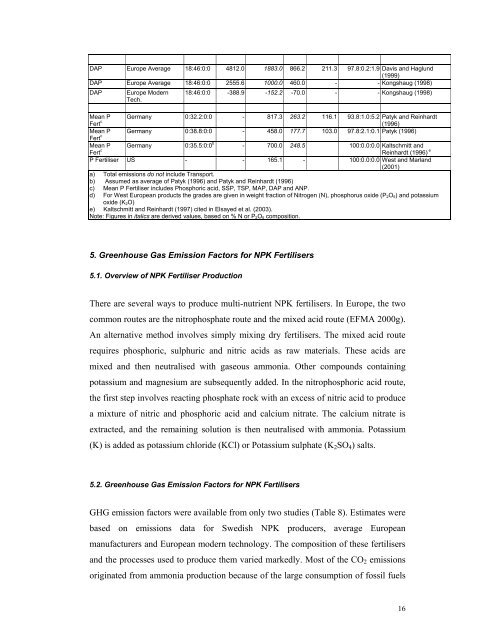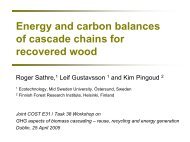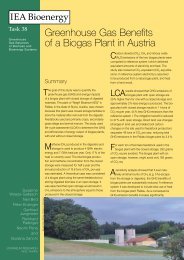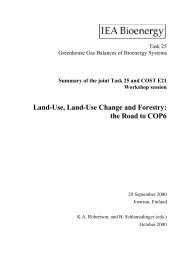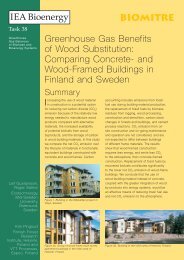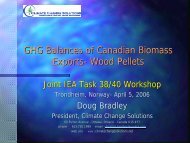A review of greenhouse gas emission factors for fertiliser production.
A review of greenhouse gas emission factors for fertiliser production.
A review of greenhouse gas emission factors for fertiliser production.
Create successful ePaper yourself
Turn your PDF publications into a flip-book with our unique Google optimized e-Paper software.
DAP Europe Average 18:46:0:0 4812.0 1883.0 866.2 211.3 97.8:0.2:1.9 Davis and Haglund(1999)DAP Europe Average 18:46:0:0 2555.6 1000.0 460.0 - - Kongshaug (1998)DAPEurope ModernTech.18:46:0:0 -388.9 -152.2 -70.0 - - Kongshaug (1998)Mean PFert c Germany 0:32.2:0:0 - 817.3 263.2 116.1 93.8:1.0:5.2 Patyk and Reinhardt(1996)Mean P Germany 0:38.8:0:0 - 458.0 177.7 103.0 97.8:2.1:0.1 Patyk (1996)Fert cMean PFert c Germany 0:35.5:0:0 b - 700.0 248.5 100:0.0:0.0 Kaltschmitt andReinhardt (1996) eP Fertiliser US - - 165.1 - 100:0.0:0.0 West and Marland(2001)a) Total <strong>emission</strong>s do not include Transport.b) Assumed as average <strong>of</strong> Patyk (1996) and Patyk and Reinhardt (1996)c) Mean P Fertiliser includes Phosphoric acid, SSP, TSP, MAP, DAP and ANP.d) For West European products the grades are given in weight fraction <strong>of</strong> Nitrogen (N), phosphorus oxide (P 2O 5) and potassiumoxide (K 2O)e) Kaltschmitt and Reinhardt (1997) cited in Elsayed et al. (2003).Note: Figures in italics are derived values, based on % N or P 2O 5 composition.5. Greenhouse Gas Emission Factors <strong>for</strong> NPK Fertilisers5.1. Overview <strong>of</strong> NPK Fertiliser ProductionThere are several ways to produce multi-nutrient NPK <strong>fertiliser</strong>s. In Europe, the twocommon routes are the nitrophosphate route and the mixed acid route (EFMA 2000g).An alternative method involves simply mixing dry <strong>fertiliser</strong>s. The mixed acid routerequires phosphoric, sulphuric and nitric acids as raw materials. These acids aremixed and then neutralised with <strong>gas</strong>eous ammonia. Other compounds containingpotassium and magnesium are subsequently added. In the nitrophosphoric acid route,the first step involves reacting phosphate rock with an excess <strong>of</strong> nitric acid to producea mixture <strong>of</strong> nitric and phosphoric acid and calcium nitrate. The calcium nitrate isextracted, and the remaining solution is then neutralised with ammonia. Potassium(K) is added as potassium chloride (KCl) or Potassium sulphate (K 2 SO 4 ) salts.5.2. Greenhouse Gas Emission Factors <strong>for</strong> NPK FertilisersGHG <strong>emission</strong> <strong>factors</strong> were available from only two studies (Table 8). Estimates werebased on <strong>emission</strong>s data <strong>for</strong> Swedish NPK producers, average Europeanmanufacturers and European modern technology. The composition <strong>of</strong> these <strong>fertiliser</strong>sand the processes used to produce them varied markedly. Most <strong>of</strong> the CO 2 <strong>emission</strong>soriginated from ammonia <strong>production</strong> because <strong>of</strong> the large consumption <strong>of</strong> fossil fuels16


